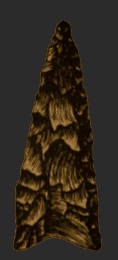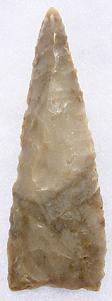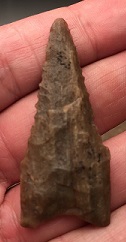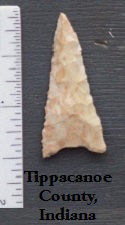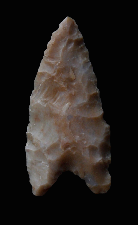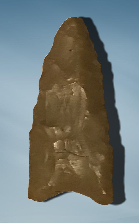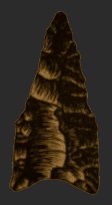Other Websites with Detailed Information:
Name Details:
Named By: Frank G. Meserve and C. B. Shultz
/ E. Mott Davis (in Bell and Hall)
Named For: Type Site
Date Identified: 1932
/ 1952
Type Site: Meserve
Bone Quarry Site (25HA1), Hall County, Nebraska
Meserve
Cluster:
Commonly Utilized Material:
Date:
Cultural Period:
9,500 -8,000 B.P.
Transitional Paleo
Early Holocene
Glacial Period:
Culture:
Outline is Representative of Size and Shape:
Description of Physical Characteristics and Flaking Pattern:
This is a medium
lanceolate point with an elliptical cross section. The blade is excurvate with the tip curving in and having parallel side approximately one third of the point. The upper portion of the blade has uni-facial beveling and grinding is seen towards the base of the blade. The base is concave and has a well thinned base.
Basal and hafting region grinding is heavy. Only one stage of
flaking is used with the removal of flakes from both faces forming a random to
oblique flaking pattern.
Size Measurements: Total Length - 30 to
90 mm, Hafting region / smoothing - typically 15 to 30 mm of total
length, Max. Width - 20 to 27 mm, Thickness - 5 to 10 mm (Suhm and Krieger, 1954).
Distribution:
Distribution Comments:
This point is found in the Plains regions
from Texas into Alberta. This point is found with decreased frequency east of the Mississippi River Valley.
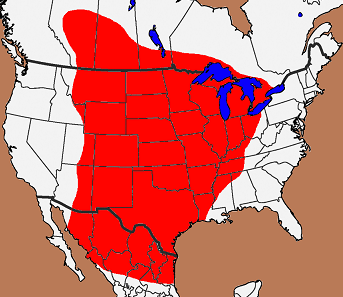
Similar Points:
Allen, Agate Basin, Angostura, Dalton, Folsom, Golondrina, Goshen, Lovell, Midland, Plainview, San Jose Additional Comments:
Suhm and Krieger (1954) state that this is a
result of a re-worked Plainview point. The hafting region is 20 to 30
mm and then the blade changes the angle. The blade can be beveled or
un-beveled, but always finely serrated. Beveling and fine serrations
are not seen on the Plainview point.
Goodyear (1982) argues that this point is re-worked lanceolate points such as Plainview points. Story et al. (1990), argues this point as an invalid type.
Suhm and Kreiger (1952) discusses the age of these points. They note
that these points have been found in association with other Plainview
points, but have also been recovered from sites containing pottery.
They feel that the age of the original Plainview point 9,500 to 8,000 is
correct, but the timespan which it was re-made depends on the age of the
site it was recovered from.
Other points in this Cluster:
Point Validity: Valid Type
Meserve was a distinguished biologist at Grand Island College who investigated the Bison
site with Shultz from the University of Nebraska State Museum. This type was named in a professional publication and has many professional references since that time. The validity of this type has come
into question, but is considered a valid type.
.
Age Details:
References: (See Reference Page, Entry Number):
8, 23, 30, 44, 115, 172, 177, 215
Meserve Projectile Point, Meserve Arrowhead

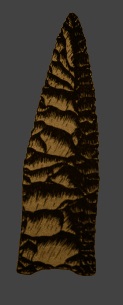
.jpg)
